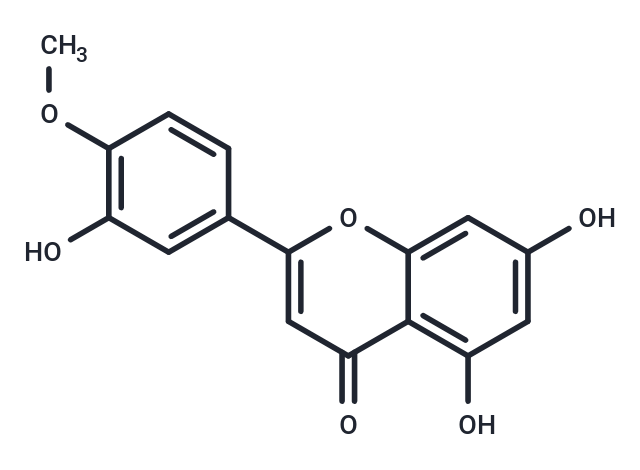Shopping Cart
- Remove All
 Your shopping cart is currently empty
Your shopping cart is currently empty

Diosmetin (Luteolin 4-methyl ether) has been found to act as a weak TrkB receptor agonist.

| Pack Size | Price | Availability | Quantity |
|---|---|---|---|
| 25 mg | $34 | In Stock | |
| 50 mg | $48 | In Stock | |
| 100 mg | $65 | In Stock | |
| 1 mL x 10 mM (in DMSO) | $50 | In Stock |
| Description | Diosmetin (Luteolin 4-methyl ether) has been found to act as a weak TrkB receptor agonist. |
| Targets&IC50 | CYP1A enzyme(human, HepG2 cells):40 μM |
| In vivo | After 6 h, 9 h, 12 h of the first cerulein injection, the severity of acute pancreatitis was evaluated biochemically and morphologically. Pretreatment with diosmetin significantly reduced serum levels of amylase and lipase; the histological injury; the secretion of tumor necrosis factor (TNF)-α, interleukin (IL)-1β, and IL-6; myeloperoxidase (MPO) activity, trypsinogen activation peptide (TAP) level, the expression of inducible nitric oxide synthase (iNOS); and the nuclear factor (NF)-κB activation in cerulein-induced AP. This study showed that administration of diosmetin demonstrated a beneficial effect on the course of cerulein-induced AP in mice. Therefore, diosmetin may become a new therapeutic agent in future clinical trials for treatment of AP. |
| Kinase Assay | Topoisomerase I Assay: One unit (the minimum amount for full relaxation of 0.5 μg SV40 DNA under the conditions of this study) of topoisomerase I, 0.5 μL of the test compounds, and 0.5μg SV40 DNA are added sequentially to the reaction buffer, which is composed of 25 mM Tris-HCl (pH 7.5), 50 mM KC1, 5 mM MgCl2, 0.25 mM EDTA disodium salt, 0.25 mM dithiothreitol, 15μg /mL bovine serum albumin, and 5% glycerol. Then, the reaction mixture (50 μL) is incubated for 10 min at 37 °C, and the reaction is terminated by treatment with 7.5 μL of a solution consisting of 1% sodium dodecyl sulfate, 20 mM EDTA disodium salt, and 0.5 mg/mL proteinase K for an additional 30 min at 37°C. The samples are mixed with 5 μL of the loading buffer containing 10 mM Na2HPO4, 31.3% sucrose, and 0.3% bromophenol blue. Relaxed (form Ir) DNA is separated from supercoiled (form I) and nicked (form II) DNA by electrophoresis on 0.8% agarose gel at 50 mA and 20 V for 17 h in the presence of 2 μg/mL chloroquine, 10 mM EDTA, 30 mM NaH2PO4, and 36 Mm Tris-HCl (pH 7.8). After electrophoresis, the gel is stained with 0.05% ethidium bromide and photographed with UV light (302 nm). The amount of DNA is quantified using a densitometer. |
| Cell Research | Diosmetin is dissolved in DMSO which is maintained at a constant concentration in control samples (2%). HepG2 cells are maintained in a humidified atmosphere of 5% CO2 at 37°C, and cultured in RPMI-1640 medium supplemented with 10% (v/v) fetal bovine serum, 100 U/mL penicillin and 100 U/mL streptomycin. HepG2 cell density is adjusted to 2×104 cells/100 μL, and the cells are seeded into 96-well plates and placed in an incubator overnight (37°C in 5% CO2) to allow for attachment and recovery. MTT analyses are performed. Briefly, cells are pretreated with 5, 10, 15 and 20 μg/mL diosmetin for 24 h. A total of 20 μL MTT solution (5 mg/mL in PBS) solution is transferred to each well to yield a final 120 μL/well and to separate wells a total of 10 μL CCK8 (5 mg/mL in PBS) is transferred. The plates are incubated for 4 h at 37°C in 5% CO2 and the absorbance is recorded at wavelengths of 595 nm and 450 nm, respectively. The half maximal inhibitory concentration (IC50) of diosmetin is calculated[1]. |
| Alias | Luteolin 4-methyl ether |
| Molecular Weight | 300.26 |
| Formula | C16H12O6 |
| Cas No. | 520-34-3 |
| Smiles | O=C1C=2C(OC(=C1)C3=CC(O)=C(OC)C=C3)=CC(O)=CC2O |
| Relative Density. | 1.517 g/cm3. Temperature:20 °C.;1.517 g/cm3. Temperature:20 °C. |
| Storage | Powder: -20°C for 3 years | In solvent: -80°C for 1 year | Shipping with blue ice. | ||||||||||||||||||||||||||||||
| Solubility Information | H2O: < 1 mg/mL (insoluble or slightly soluble) DMSO: 18.33 mg/mL (61.06 mM), Sonication is recommended. Ethanol: < 1 mg/mL (insoluble or slightly soluble) | ||||||||||||||||||||||||||||||
Solution Preparation Table | |||||||||||||||||||||||||||||||
DMSO
| |||||||||||||||||||||||||||||||

Copyright © 2015-2025 TargetMol Chemicals Inc. All Rights Reserved.